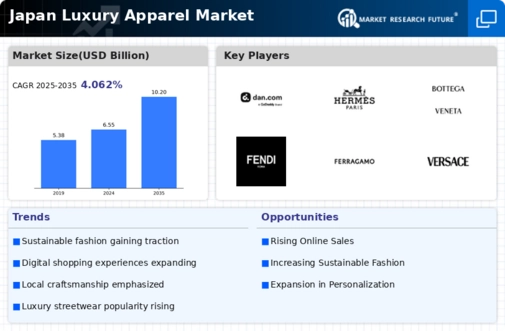The luxury apparel market in Japan is characterized by a dynamic competitive landscape, driven by a confluence of consumer demand for high-quality products and the increasing influence of digital channels. Major players such as LVMH (FR), Kering (FR), and Gucci (IT) are strategically positioned to leverage innovation and regional expansion. LVMH (FR) continues to enhance its portfolio through acquisitions, while Kering (FR) focuses on sustainability initiatives, aiming to resonate with environmentally conscious consumers. Gucci (IT) emphasizes digital transformation, integrating advanced technologies to enhance customer engagement, thereby shaping a competitive environment that prioritizes brand loyalty and innovation.
Key business tactics within this market include localizing manufacturing and optimizing supply chains to enhance responsiveness to consumer preferences. The competitive structure appears moderately fragmented, with several key players exerting substantial influence. This fragmentation allows for niche brands to thrive alongside established luxury houses, creating a diverse market landscape that fosters innovation and competition.
In September 2025, Kering (FR) announced a partnership with a leading Japanese textile manufacturer to develop sustainable fabrics, reflecting a commitment to eco-friendly practices. This strategic move not only aligns with global sustainability trends but also positions Kering (FR) as a leader in responsible luxury, potentially attracting a broader consumer base that values ethical production.
In October 2025, Gucci (IT) launched an augmented reality (AR) feature in its mobile app, allowing customers to virtually try on apparel. This initiative underscores the brand's focus on digital engagement and enhances the shopping experience, likely increasing customer retention and driving sales in a competitive digital landscape. The integration of AR technology may also set a precedent for other luxury brands to follow, indicating a shift towards immersive shopping experiences.
In August 2025, LVMH (FR) unveiled a new flagship store in Tokyo, designed to showcase its commitment to luxury retail. This expansion not only reinforces LVMH's presence in a key market but also highlights the importance of physical retail spaces in an increasingly digital world. The flagship store is expected to serve as a hub for exclusive events, further solidifying brand loyalty among affluent consumers.
As of November 2025, current competitive trends in the luxury apparel market are increasingly defined by digitalization, sustainability, and the integration of artificial intelligence (AI). Strategic alliances among brands and technology firms are shaping the landscape, fostering innovation and enhancing operational efficiencies. The competitive differentiation appears to be shifting from price-based strategies to a focus on innovation, technology, and supply chain reliability, suggesting that brands that prioritize these elements may gain a competitive edge in the evolving market.

























Leave a Comment